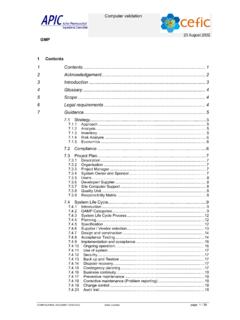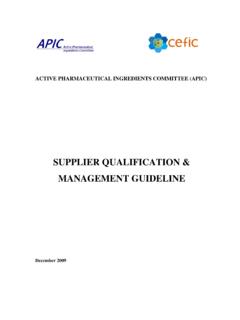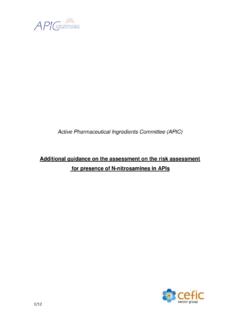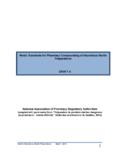Transcription of Quality Management System - apic.cefic.org
1 Quality Management SystemforActive pharmaceuticalIngredients manufacturers Integrating GMP into ISO 9001 December 1997 Quality Management System - integrating GMP into ISO1 Table of and development of customer-supplied and equipment identification and process and of inspection, measuring and test and test of nonconforming and preventive , storage, packaging, preservation and of Quality Quality A: B: Facilities and cleaning, utilities and C: D: Change and System performance Management System - integrating GMP into ISO2A. AcknowledgementsThe BPCC, a sector group of CEFIC acknowledges the following documents which have beenused as basis for the establishment of the present guideline:-EFPIA/CEFIC Good Manufacturing Practices for Active Ingredient Manufacturerspublished in August 1996, and- EN ISO 9001 Quality Systems: Model for Quality Assurance in Design, Development,Production, Installation and Servicing published in July members of the BPCC ad hoc working group who developed and prepared this documentare as follows: W.
2 Adams (Merck Sharp & Dohme) L. Hartmann (Hoffmann-La Roche) R. Hopkins (GlaxoWellcome) L. de Morsier (Chair, Novartis) A. Rossetti (Pharmacia & Upjohn) J. Ruiz (Esteve Quimica) Teward (GlaxoWellcome).We wish to thank the Secretary General of the European Committee for Standardisation forconfirming that this document does not violate any CEN copyright Management System - integrating GMP into ISO3B. IntroductionBecause the pharmaceutical industry has traditionally focused upon the application of GoodManufacturing Practice (GMP), it has been slow to consider the potential benefits to be gainedby implementing an EN ISO 9001 Quality Management System (QMS).Over the last few years the global pharmaceutical market has undergone significant change,forcing pharmaceutical companies, more than ever before, to focus on customer needs andupon their own internal efficiency in order to continue to compete this in mind CEFIC commissioned a working group of experts drawn from several majorActive Pharmaceutical Ingredients (API) producers to prepare a practical, user-friendlyguidance document integrating current GMP requirements into the EN-ISO 9001 QMSframework.
3 To achieve this the working group have taken relevant features from the August1996 CEFIC/EFPIA publication Good Manufacturing Practice for Active IngredientsManufacturers and combined these with the relevant complementary requirements of EN-ISO9001 Quality Systems: Model for Quality assurance in design, development, production,installation and servicing . It is intended that these Guidelines are applicable to all , in the case of a sterile API , the Guidelines should be applied at least to the point atwhich the API enters a sterilising facilitate understanding of this composite guidance document it is important for the readerto be aware of the following points: EN-ISO 9001 is a generic, business focused, standard which supports the effectivemanagement of Quality to an internationally recognised level of best practice.
4 It isflexible in that it specifies what is to be achieved, but allows each company freedom todetermine, and justify, how these requirements are achieved. In contrast, GMP is anindustry-specific standard prescribing what must be done to ensure product safety andefficacy. Thus, EN-ISO 9001 benefits the business by ensuring the Quality of themanagement System , while GMP ensures that regulatory requirements are met. Although there is inevitably some overlap between the requirements of a QMS and GMPthey are, in fact, highly complementary. This view is supported by a statement in theintroduction to the PIC (International Inspection Convention) GMP Guideline whichrefers to .. a correctly implemented System of Quality Assurance incorporating , and by the wording of the introduction in ISO itself which points out that.
5 This international standard is complementary - not alternative - to the technical (product)specified requirements . The interrelationship between EN-ISO 9001 and API GMP is illustrated in this guidancedocument by a matrix cross-referencing the main QMS elements and GMP Management System - integrating GMP into ISO4 To be effective the QMS should have the visible and ongoing support of topmanagement. To fully benefit the company the QMS should involve all staff whose activities influencequality, have a clear and unambiguous continuous improvement focus, and incorporaterelevant, realistic performance measures with emphasis on reducing failure costs, andsatisfying (internal and external) customer needs. The Quality manual occupies the highest level in the document hierarchy. It overviewsand acts as a directory to the QMS, capturing the unique character of the company.
6 An effective QMS has a minimum of paperwork, and should constantly question the needfor the existing documents. In contrast, a bureaucratic and inefficient QMS will arise ifthe Standard is misinterpreted, and incorrectly the purpose of this guidance document, the original EN-ISO 9001 subclauses have beenaddressed in twenty distinct chapters supplemented by four annexes in recognition of theimportance of issues concerning hygiene; facilities and utilities; validation; and change control,to the API industry. Each chapter and each of the four annexes are structured in a way whichsummarises the appropriate QMS principle and philosophy as a preface to the main text whichintegrates relevant GMP requirements and QMS principles. The rationale/justification andbusiness benefits of a combined QMS/GMP approach are considered in chapter 6.
7 Chapter 7addresses the importance of lower level and higher level performance measures for continuedsuccess, and as a solid foundation for those wishing to progress to European QualityAward/World Class , health and environment are not specifically addressed. However, it is widelyacknowledged that implementation of a robust QMS provides a sound basis for the futuredevelopment of such an Integrated Management this Guide the term should indicates requirements that are expected to apply unless shownto be inapplicable or replaced by an alternative demonstrated to provide at least an equivalentlevel of Quality Management System - integrating GMP into ISO5C. GlossaryPrincipleThis glossary covers the meaning of the words used in this Pharmaceutical Ingredient (API)Any pharmaceutically active material from organic, inorganic, microbiological, animal or plantorigin, including that produced by recombinant DNA methods, intended for use in themanufacture of a medicinal product for human and or veterinary and independent examination to determine whether Quality activities and relatedresults comply with Quality policy and if this policy has been implemented (or lot)A defined quantity of a material produced in a process or series of processes so that it isexpected to be homogeneous within specified limits.
8 In the case of continuous production thebatch (or lot) may be defined by a fixed quantity or number (or lot number)A distinctive combination of numbers and/or letters which specifically identifies a batch or lotand from which the production history can be of measuring instrument performance against an approved standard leading, ifappropriate, to correction of performance of the deliberately introduced modification to existing documents, processes, equipment, systemsor testing Management System - integrating GMP into ISO6 Change controlFormal System to evaluate effects of any systemA System including the input of data, electronic processing and the output of information to beused either for reporting or automatic systemA System including computer System , all sensors, transmitters, actuators and wiring needed tocontrol the statusStatus given to a material waiting to be fully tested and formally of specified unintended, non-process related.
9 Introduction of impurities of a chemical ormicrobiological nature, or of foreign matter, into or onto a material during production,sampling, packaging or repackaging, storage or productionA process in which a material is continuously produced in a step or series of steps. In acontinuous process the batches of raw materials and the process parameters can be statistically,but not necessarily, correlated to the material produced in a given window of reviewSystematic activities carried out by the supplier before signing the contract to ensure thatrequirements are adequately defined, free from ambiguity, documented and Management System - integrating GMP into ISO7 Corrective actionAction taken to rectify an identified nonconformity, defect or other undesirable situation and toprevent contaminationA particular form of contamination in which material from one product contaminates of a product or service provided by the reviewDocumented, comprehensive and systematic examination of a design to evaluate its capabilityto fulfil agreed requirements for Quality .
10 It will identify problems, if any, and propose thedevelopment of dateThe date placed on the container/labels of an API designating the time during which the API isexpected to remain within established shelf life specifications if stored under definedconditions, and after which it should not be intermediateThe last compound from which the API is produced. In the case of organic compounds thismeans a change in at least one covalent bond, whilst for inorganic compounds this may mean achange in an ionic bond. The final intermediate is thus a starting material for the process stepwhich produces the finished component present in the API other than the substance defined as the Management System - integrating GMP into ISO8In-process controlChecks performed during production in order to monitor and, if necessary, to adjust theprocess, including repeating a process step, to ensure that the process performs as monitoring of the environment or utilities may also be regarded as part of the such as measuring, examining.



